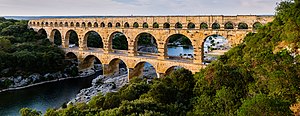Technological history of the Roman military
This article needs additional citations for verification. (October 2011) |
 |
| Part of a series on the |
| Military of ancient Rome |
|---|
|
|
The technology history of the Roman military covers the development of and application of technologies for use in the armies and navies of Rome from the
Origins and development
Much of what is described as typically Roman technology, as opposed to that of the Greeks, comes directly from the Etruscan civilization, which was thriving to the North when Rome was just a small kingdom. The Etruscans had invented the stone arch, and used it in bridges as well as buildings. Some later Roman technologies were taken directly from Greek civilization.
After the absorption of the ancient Greek city states into the Roman Republic in 146 BC, the highly advanced
New materials
However, the Romans made many significant technological advances, such as the invention of

Mining
The Romans also used water power in an unexpected way during mining operations. It's known from the writings of
The outflow was channelled into sluice boxes, and the heavier gold collected on rough pavements. They also developed many deep mines, such as those for

The period in which technological progress was fastest and greatest was during the 2nd century and 1st century BC, which was the period in which Roman political and economic power greatly increased. By the 2nd century, Roman technology appears to have peaked.
Roman implementation of technology
The Romans advanced military technology significantly, and implemented it on a massive scale. From a few early models of ballista from Greek city-states the Romans adopted and improved the design, eventually issuing one to every century in the legions.
To facilitate this organization, an engineering corps was developed. An officer of engineers, or praefectus fabrum, is referenced in armies of the Late Republic, but this post is not verifiable in all accounts and may have simply been a military advisor on the personal staff of a commanding officer.[2] There were legion architects (whose rank is yet unknown), who were responsible for the construction of war machines. Ensuring that constructions were level was the job of the libratores, who would also launch missiles and other projectiles (on occasion) during battle.[3] The engineering corps was in charge of massive production, frequently prefabricating artillery and siege equipment to facilitate its transportation [4]
See also
- Roman military engineering
- Roman aqueducts
- Roman technology
- Sanitation in ancient Rome
Notes
References
- Primary sources
External links
- Roman Swords in the Republic and After, [1]
